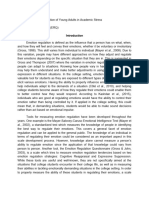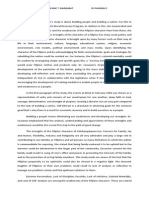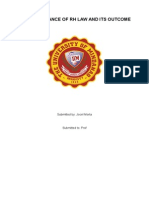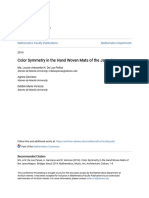Albert Bandura
Albert Bandura
Uploaded by
Rachel NoelCopyright:
Available Formats
Albert Bandura
Albert Bandura
Uploaded by
Rachel NoelCopyright
Available Formats
Share this document
Did you find this document useful?
Is this content inappropriate?
Copyright:
Available Formats
Albert Bandura
Albert Bandura
Uploaded by
Rachel NoelCopyright:
Available Formats
Albert Banduras Social Cognitive Theory
By ANANDA | Published: MARCH 26, 2006
From a very early point in the history of philosophy, philosophers have been asking questions about human nature and about how we develop. These questions have led to a range of theories about human development and have extended from the philosophical sphere into the realms of psychology and educational research. Along with this expansion into other areas of studies, the questions being asked are also changing. Earlier educational and psychological theories, for example, focused largely on behaviorism as the source of human development while recent theories have increasingly been integrating the role of cognition in the development process. Despite being only theories with flaws and without definite answers, these theories are very valuable to educators. There are three main categories of thought distinguishing these educational theories: developmental, environmental, and crossover. While there is variation in the ideas of theorists within each group, there are a few generalizations that can be made about each. The following paragraphs will give some very basic background into each theory to help illustrate the differences between them. Development theories include Jean Piagets stages of cognitive development, Lawrence Kholbergs stages of moral development, and Eric Eriksons stages of psychological development. These theories are primarily based on cognitive processes and rarely, if ever, include introspective processes. The individuals perception of the world changes during each sequential development stage and individuals cannot skip development stages. B. F. Skinners operant conditioning, Edward Thorndikes law of effect, and Ivan Pavlovs classical conditioning are all examples of environmental theories. For many environmental theorists, the idea of free will is an illusion. Behavior is fully conditioned and determined by outside forces including genetic factors or environmental inputs. Some examples of crossover theories include William Glassers choice theory, Lev Vygotskys zone of proximal development, and Albert Banduras social cognitive
theory. Crossover theorists may ask questions like What is the role of consciousness in behavior and development? or How does ones self-identity affect their decision making process? In addition to acknowledging the impact of external forces, crossover theorists also often include cognitive processes when analyzing behavioral choices. Unlike other species, humans are not born with instinctive survival skills, yet we are the most developed species on Earth, having constantly adapted the environment to suit our needs. As humans, we are constantly learning from each other and always building on what we know. For example, parents raising children today have much more information about how to prepare for the moments before childbirth. Doctors are better prepared to conduct the delivery of a child and ensure that both the mother and child survive the process. With such a view, can we really say that all of our learning is structured, intentional and pre-determined as would be the perspective of environmentalism? Similarly, can we fully remove the effect of the environment-imagine someone unable to afford a decent hospital in a developing country-on our development and focus on cognitive processes? Albert Bandura felt that neither approach was entirely satisfactory. From the point of view of behaviorism, all that we know is a series of conditioned responses. This view, while it did help explain some behaviors, was very narrow and mechanical and would not explain why we have such advanced cognitive abilities and how we have progressed so far. To deal with these shortcomings, Bandura expanded the work of development theories to include ideas from cognitive theories. He promoted the concept of what he ultimately termed social cognitive theoryAlthough Banduras work is often referred to as social learning, he chose to change his theorys label from learning to cognitive because he wanted to place an emphasis on the role of cognition on things like our perception of reality and out ability to self-regulate (Pajares, 2002)., a key component of which is an individuals perception of their self-efficacy. He also wrote of how we learn to make the best of chance encountersan subject in psychology he felt was particularly lacking. This paper will look at Banduras social cognitive theory in more detail and explain what he means by selfefficacy.
Before jumping into Banduras theories of human development, here is a brief biographical sketch. Bandura was the youngest of six children and grew up in a small town in Canada. His elementary school and high school years were spent at the only school in this small town where, because of scarce resources, students often worked based on their own initiative. He happened onto psychology by chance when he was attending the University of British Columbia and needed an early class to complete his schedule. He continued his study of psychology at the University of Iowa where he went on to receive his masters degree and his PhD (Pjares, 2004). Banduras earlier work focused on aggressive behavior developed through social learning. His initial theories were based on his observations of adolescents coming from families where the parents also displayed aggressive behavior. However, his most significant work in this area involved his study of preschool children (Ormrod & Rice, 2003). His experiment involved the placement of a blow-up doll in a room of toys and exposing three separate groups of preschool children to different behaviors in the playroom. One group saw an adult being aggressive towards the doll, hitting it with wooden mallets and other objects and using aggressive language towards it. A second group saw an adult come in and play constructively with other toys in the room and display no violent behavior. A third group had no adult modeled behavior in the playroom. Later placed in the room with the blow-up doll, the children who saw the aggressive behavior were the most aggressive of the three groups and the children who saw the adult engaged in constructive, non-aggressive behavior were the least aggressive of the groups. What this illustrated for Bandura was the importance of modeling in social cognitive theory. In one of his earlier articles, Bandura (1963) acknowledges that some behaviors are indeed the result of direct training or conditioning of some form. He feels that certain things, personality patterns for example, come from modeled behavior, usually the behavior of the parents. He gives the example of a parent hitting a child as punishment for things like bullying or fighting with peers. The purpose of the punishment is to decrease the aggressive behavior, but in fact, the act is teaching the child other forms of aggression to imitate. This form of modeling is not restricted to parents, however. Bandura repeated the blow-up doll experiment (1963) to have children watching videos, some with human
models and some with cartoon characters, with videos portraying similar behavior to the earlier mentioned example. Bandura had other groups this time; some videos were extended to let children see the aggressor being punished as a consequence of bad behavior. Bandura observed the same pattern of behavior was displayed by viewers who did not see the extended videos, but observed a decrease in the undesirable behavior by children who saw the consequences of the action. This reinforced the idea that we can learn how to act based on our observations alone and that the subjects we observe do not have to be live models but can be abstractions of reality. In fact, in a more recent study, Bandura (2001) wrote: Televised representations of social realities reflect ideological bents in their portrayal of human nature, social relations, and the norms and structure of society (Adoni & Mane, 1984; Gerbner, 1972). Heavy exposure to this symbolic world may eventually make the televised images appear to be the authentic state of human affairs. (p. 12) Modeling is also present in how we develop language abilities (Bandura, 1989). While we may use abstract terms when talking with adults, we do not model that action with children. Parents who use language that matches the cognitive abilities of their children at different stages will help children develop language skills more quickly. Parents can also actively promote language development by modeling more progressive linguistic concepts as their childrens language skills develop. In addition to introducing new elements of language into childrens experience, parents can also promote language development by restating their childrens comments using a different syntax than the syntax used by their children. This models different ways of expressing the same things and helps children develop linguistic and cognitive skills more quickly. There is good reason that Bandura puts a lot of weight on the social cognitive theory that he proposes. Using the principles of the theory shows us that not only can modeling teach us behaviors, it can also teach us judgment, morality, and help develop cognitive abilities (Bandura, 1989). The development of cognitive abilities is of particular interest because it shows us that modeling can be seen in two fundamentally different-yet both relevant and applicable-ways. From one perspective, responses to modeling are somewhat concrete; individuals mimic the
modeled behavior very closely as in the case of aggressive behavior. From an alternate perspective, responses to modeling are quite abstract; individuals can transpose information they have gained from one modeled scenario and apply it in different areas. These ideas are important because they mean that we do not necessarily have to experience something to know how to behave or respond. An example, again using linguistics, would be our ability to construct similar sentences about entirely different things based on an abstract idea of appropriate syntax. This also means that we are able to develop a sense of empathy in our emotions. Notice from the above explanations that there is still a considerable amount of determinism that factors into social cognitive theory. For example, not everyone will have parents who can appropriately model sequentially advanced linguistic structures, so the development opportunities for those children may be more limited. Because social cognitive theory accepts a certain element of determinism in development, it is helpful to consider the position of the individual amongst other deterministic inputs (Pjares, 2002). Bandura proposes a form of what he terms reciprocal determinism which is a tri-modal interplay between the individual, behavior, and the environment. Essentially, what Bandura is trying to illustrate with this model is that we are not simply reactive organisms but that we have the ability to actively alter our environment and our behavior (1998). Consider the following interdependencies and their modes of reciprocity. In considering the dynamics between the individual and behavior, behavior depends on elements such as the individuals expectations or goals. Similarly, behavior can be conditioned, thus controlling the individual. Individual achievement can be hindered by environmental inputs such as socioeconomic factors; these effectively limit the individuals access to certain developmental opportunities. However, just as the environment affects individuals, so too can individuals affect their environment; a strict boss, for example can alter the environment of a room with their only action being their entry into the room. Our behavior also determines our environment. In our daily lives, our environment may be quite limited, consisting only of our work or home settings. Similarly, since our environment is not a static one, it can have an effect on our behavior. Basically, all of these interrelations and the inclusion of the individual in the process of their own development help lay the groundwork for one of the main recurring
theories underlying Banduras work. In his paper Social Cognitive Theory of SelfRegulation, Bandura (1991) writes: People possess self-reflective and self-reactive capabilities that enable them exercise some control over their thoughts, feelings, motivations and actions. In the exercise of self-directedness, people adopt certain standards of behavior that serve as guides and motivators and regulate their actions anticipatorily through self-reactive influence. Human functioning is, therefore, regulated by an interplay of selfgenerated and external sources of influence. (p. 249) As we can see, in comparison to many other theories of human development, this places a lot of responsibility on the individual in terms of how much they are affected by determinism. Central to social cognitive theory and critical for the ability for individuals to engage in the sort of self-regulation that Bandura refers to above is the concept of selfefficacy. Self-efficacy is the idea that people decide how to behave based more on their belief in their own capabilities of accomplishment rather than in their knowledge or skills (Pajares, 2002). Self-efficacy is not a simple believe in yourself and you will succeed concept because certain knowledge, skills, and experiences are also prerequisites to success. Still, self-efficacy is important for several reasons. It helps determine our life choices, it motivates us, and it helps us deal with failures and setbacks in life (Bandura, 1994). That said, peoples self-efficacy and their actual skills or abilities do not always match or combine in productive ways. Sometimes, someone who is extremely skillful or knowledgeable may actually have low selfefficacy, thus hindering their abilities to accomplish grander things. Having varied levels of self-efficacy among individuals can help explain why two individuals with very similar skills and knowledge can end up exhibiting extremely different behaviors. The good thing about self-efficacy is that it can be developed over time. Bandura (1994) identifies four main sources of self-efficacy. First, experiences in which the individual can experience success helps build self-efficacy. However, success should not come too easily, since if success always comes easily, it is likely that when the individual encounters failure, they will have a harder time recovering from it.
Second, self-efficacy can be built by the observation of models similar to the individual who are achieving success. The strength of the self-efficacy is more strongly influenced if the individual associates very closely with the model. Third, encouragement or persuasion by others is another source of self-efficacy. While not usually totally effective on its own, persuasion accompanied by the identification of elements which may enhance the likelihood of success are more likely to improve self-efficacy. Finally, self-efficacy is also built based on an individuals judgment of the state of their bodies-for example personal strength or tiredness-and their emotional state. For educators, Banduras theories hold several implications. Ideas of conditioning can still be used in the classroom to help classroom management; however, since teachers cannot control the environment the students encounter outside school, teachers should also look into ways in which they can help students build selfefficacy. This requires a setting in which individuals can succeed, but also an environment in which individuals are adequately challenged. Teachers should use a multi-dimensional approach to disseminating knowledge to their students thus helping students develop different cognitive capabilities. Teachers should also be models for their students and be ready to explain differences in their modeled behavior from behavior that may be modeled in popular media. Creating an educational environment as mentioned above will give individuals the tools necessary to take an active role in their education. Additionally, having helped develop high self-efficacy, teachers will have enabled students with the skills to cope with the difficulties that one encounters in life. Bandura (1999) mentions a proverb when writing of how self-efficacy can help people deal with these difficulties: You cannot prevent the birds of worry and care from flying over your head. But you can stop them from building a nest in your hair. Additionally, high self-efficacy can help make people make the most of chance encounters. As we can see from the discussion above, our knowledge of cognitive abilities and an individuals environment is not enough to predict how our lives will end up. Bandura (1982) feels that our ability to accurately predict outcomes is even further complicated by how different people deal with chance encounters. While his analysis of chance encounters is too extensive for the scope of this paper, it still does
shed some light on another reason self-efficacy is important: our lives are full of chance encounters which may be quite fortuitous, and if we have low self-efficacy, we are less likely to take the chances these offer us and are more likely to be stuck in a somewhat stagnant lifestyle. There are some things, for example our genetic makeup, that we have no real control over. However, we are not slaves to our environment. Given the necessary foundation for growth and achievement, we can escape the traditionally held confines of elements like poverty, gender constructs, or access to education and take personal control and responsibility of our life outcomes.
References
Bandura, A. (1963). The role of imitation in personality development. The Journal of Nursery Education, 19(3). Bandura, A. (1984). The psychology of chance encounters and life paths. American Psychologist, 37(7). Bandura, A. (1989). Social cognitive theory. In R. Vasta (Ed.), Annals of child development. Vol. 6. Six theories of child development (1-60). Greenwich, CT: JAI Press. Bandura, A. (1991). Social cognitive theory of self-regulation. Organizational Behavior and Human Decision Processes 50 (248-287). Bandura, A. (1994). Self-efficacy. In V. S. Ramachaudran (Ed.), Encyclopedia of human behavior (Vol. 4, 71-81). New York: Academic Press. (Reprinted in H. Friedman [Ed.], Encyclopedia of mental health. San Diego: Academic Press, 1998). Bandura, A. (1999). A social cognitive theory of personality. In L. Pervin & O. John (Ed.), Handbook of personality (2nd ed., 154-196). New York: Guilford Publications. (Reprinted in D. Cervone & Y. Shoda [Eds.], The coherence of personality. New York: Guilford Press.) Bandura, A. (2001). Social cognitive theory of mass communications. In J. Bryant, & D. Zillman (Eds.). Media effects: Advances in theory and research (2nd ed. 121-153). Hillsdale, NJ: Lawrence Erlbaum. Ormrod, J. E. & Rice, F. P. (2003). Lifespan development and learning. Boston, MA: Pearson Custom Publishing.
Pajares (2002). Overview of social cognitive theory and of self-efficacy. Retreived March 20, 2006, from http://www.emory.edu/EDUCATION/mfp/eff.html Pajares, F. (2004). Albert Bandura: Biographical sketch. Retrieved March 20, 2006, from http://www.emory.edu/EDUCATION/mfp/bandurabio.html
This entry was posted in Master's, School Papers and tagged Albert Bandura,education, nature vs nurture, social cognitivism, the process of learning, UOP. Bookmark the permalink. Post a comment or leave a trackback: Trackback URL.
You might also like
- (PDF Download) Pachinko Full Ebook by Min Jin Lee: DetailsDocument4 pages(PDF Download) Pachinko Full Ebook by Min Jin Lee: DetailsRabeya Arefin Tonni14% (7)
- Celebrity FMTDocument4 pagesCelebrity FMTChuanli Kong90% (31)
- Connectivity Level 3 Teachers Book UNIT 1 v2Document12 pagesConnectivity Level 3 Teachers Book UNIT 1 v2Adderly Sandoval BarcoNo ratings yet
- Escalas de EfronDocument2 pagesEscalas de Efronkarina100% (1)
- Diagnosis - Reflective EssayDocument3 pagesDiagnosis - Reflective EssayConnor JefferiesNo ratings yet
- Psychology Lab ReportDocument8 pagesPsychology Lab ReportHelena Couto100% (1)
- Franchise Agreement Nanyang F 0BDocument10 pagesFranchise Agreement Nanyang F 0BKenny LimNo ratings yet
- Educ Related Politics and Culture Youth: Topics Educational Discussion MaterialDocument3 pagesEduc Related Politics and Culture Youth: Topics Educational Discussion MaterialAlex SantosNo ratings yet
- Biography of Albert Bandura: LearningDocument6 pagesBiography of Albert Bandura: LearningRustumme Mirelle Reyes100% (1)
- J. Mouton - , H.C. Marais-Basic Concepts - The. Marais-Basic Concepts - The. Marais-Basic Concepts - The PDFDocument285 pagesJ. Mouton - , H.C. Marais-Basic Concepts - The. Marais-Basic Concepts - The. Marais-Basic Concepts - The PDFRaluca ApetreiNo ratings yet
- One Side ACC With IPA SymbolsDocument1 pageOne Side ACC With IPA SymbolsSerena ReviewsNo ratings yet
- Cause and Effect - 201621567Document2 pagesCause and Effect - 201621567api-331227200No ratings yet
- Alcaide Boston (Chapters 1 3)Document26 pagesAlcaide Boston (Chapters 1 3)Crystal Gift S. Boston100% (1)
- 40 Political Issues Research Paper Topics - A Research Guide For Students PDFDocument4 pages40 Political Issues Research Paper Topics - A Research Guide For Students PDFElmir EzimovNo ratings yet
- The Effect of Mental Health On The Academic Performance of Senior High Students in Pinagbuhatan High SchoolDocument2 pagesThe Effect of Mental Health On The Academic Performance of Senior High Students in Pinagbuhatan High SchoolXyril Ricaella AlvaradoNo ratings yet
- BehaviorismDocument11 pagesBehaviorismRitchelle LamayoNo ratings yet
- School ThoughtsDocument3 pagesSchool ThoughtsDaveMarkGMendozaNo ratings yet
- Nature of Social Inequality in The PhilippinesDocument2 pagesNature of Social Inequality in The PhilippinesJacquelyn GuintoNo ratings yet
- Chapter 3 Conventional Morality and Ethics TheoryDocument35 pagesChapter 3 Conventional Morality and Ethics TheoryTia Nurul AfifahNo ratings yet
- Albert BanduraDocument3 pagesAlbert Bandurafranz mallariNo ratings yet
- Emotional Regulation - RRLDocument3 pagesEmotional Regulation - RRLNaynay PaypayNo ratings yet
- Moral RecDocument2 pagesMoral RecDarwin MangabatNo ratings yet
- Social Constructivism PDFDocument17 pagesSocial Constructivism PDFHaroon BilalNo ratings yet
- Student Self-Efficacy in Introduction To Accounting: A Case Study From TurkeyDocument9 pagesStudent Self-Efficacy in Introduction To Accounting: A Case Study From TurkeyJoy Villavicencio100% (1)
- Exploring Fan Passions Driving Consumer Engagement The Case of Philippine K Pop and K Drama FansDocument38 pagesExploring Fan Passions Driving Consumer Engagement The Case of Philippine K Pop and K Drama FansHeather RaymundoNo ratings yet
- Parental Involvement, Difficulties and Academic Achievements of Students Amidst The PandemicDocument10 pagesParental Involvement, Difficulties and Academic Achievements of Students Amidst The PandemicBlundell Gayle Pascua BautistaNo ratings yet
- Jeep 101Document14 pagesJeep 101Cristel Isa OpadaNo ratings yet
- Research Essay - ConfidenceDocument4 pagesResearch Essay - Confidenceapi-255939730No ratings yet
- Attitudes of Parents Towards Their Mentally Retarded Children A Rural Area Examination - N Govend PDFDocument101 pagesAttitudes of Parents Towards Their Mentally Retarded Children A Rural Area Examination - N Govend PDFUzmaShiraziNo ratings yet
- Theories of Crime Causation MidtermDocument5 pagesTheories of Crime Causation MidtermjoseNo ratings yet
- Mercy KillingDocument2 pagesMercy Killinglianghoo94No ratings yet
- Global CitizenshipDocument5 pagesGlobal CitizenshipBianca VacunawaNo ratings yet
- Behaviorism: Behaviorism Is The Study and Analysis of Observable BehaviorDocument15 pagesBehaviorism: Behaviorism Is The Study and Analysis of Observable BehaviorNizar Jan MhbNo ratings yet
- Child Abuse in Bangladesh: A Silent CrimeDocument17 pagesChild Abuse in Bangladesh: A Silent CrimeEzaz Leo84% (19)
- Gender DevelopmentDocument40 pagesGender DevelopmentPol AnduLanNo ratings yet
- EthicsDocument31 pagesEthicsALI KAMRANNo ratings yet
- Local Government-Volunteer Collaboration For Disaster Risk Management in The PhilippinesDocument123 pagesLocal Government-Volunteer Collaboration For Disaster Risk Management in The PhilippinesReiou ManuelNo ratings yet
- The Significance of RH Law and Its OutcomeDocument7 pagesThe Significance of RH Law and Its Outcomeannuj738100% (1)
- Understanding The SelfDocument2 pagesUnderstanding The SelfsamcaridoNo ratings yet
- Chapters 1 and 2 STSDocument38 pagesChapters 1 and 2 STSJohn Carlo CastilloNo ratings yet
- Psych 1st ExamDocument19 pagesPsych 1st ExamMTCNo ratings yet
- Effectiveness of Occupational Therapy Intervention in Borderline Personality Disorder and Post-Traumatic Stress DisorderDocument9 pagesEffectiveness of Occupational Therapy Intervention in Borderline Personality Disorder and Post-Traumatic Stress DisorderTariqual IslamNo ratings yet
- Labelling TheoryDocument18 pagesLabelling Theoryapi-291832916No ratings yet
- Mustangs For A Better FutureDocument24 pagesMustangs For A Better FutureMustangs For a Better FutureNo ratings yet
- Midtrem EssayDocument3 pagesMidtrem EssayNikka Jean Duero LachicaNo ratings yet
- Social Vices and Negative Conduct in Nigeria: Aetiologies and ProphylaxesDocument32 pagesSocial Vices and Negative Conduct in Nigeria: Aetiologies and ProphylaxesIgbereyivwe TejiriNo ratings yet
- Opinion On Ambisyon Natin 2040Document2 pagesOpinion On Ambisyon Natin 2040gaa77droidsNo ratings yet
- Neo BehaviorismDocument18 pagesNeo Behaviorismchinie mahusayNo ratings yet
- Helping Behavior in Rural and Urban Environments A Meta-Analysis.Document11 pagesHelping Behavior in Rural and Urban Environments A Meta-Analysis.ericjimenezNo ratings yet
- Personality and SocializationDocument9 pagesPersonality and SocializationRhazellaCuasayNo ratings yet
- Foreign LitDocument4 pagesForeign LitElaiza DagaleNo ratings yet
- Lev VygotskyDocument5 pagesLev VygotskyAnonymous FxDBKWNo ratings yet
- Child Abuse and Its Impact On Students' Psychological Well Being in NDU MunicipalityDocument19 pagesChild Abuse and Its Impact On Students' Psychological Well Being in NDU MunicipalityEditor IJTSRDNo ratings yet
- Teaching Individuals With Developmental Disabilities Basic Cooking Skills: A Single Case ResearchDocument16 pagesTeaching Individuals With Developmental Disabilities Basic Cooking Skills: A Single Case ResearchConstantinos MantzikosNo ratings yet
- Humanistic PsychologyDocument10 pagesHumanistic PsychologyAriane Descaya BenerioNo ratings yet
- Last Na TalagaDocument74 pagesLast Na TalagaJemica RodriguezNo ratings yet
- Social Work Action Plan 3-16-12Document6 pagesSocial Work Action Plan 3-16-12JENNYNo ratings yet
- Psycological EssayDocument2 pagesPsycological Essayapi-431658211No ratings yet
- Dependency Theory: (Or: Media System Dependency Theory) History and OrientationDocument4 pagesDependency Theory: (Or: Media System Dependency Theory) History and OrientationeaberaNo ratings yet
- St. Peter's College of Misamis Oriental, Inc. 15th de Septiembre ST., Balingasag, Misamis Oriental Academic Year 2020 - 2021Document25 pagesSt. Peter's College of Misamis Oriental, Inc. 15th de Septiembre ST., Balingasag, Misamis Oriental Academic Year 2020 - 2021AllyzzaNo ratings yet
- Basics of Human NatureDocument16 pagesBasics of Human NatureAmar Sharma100% (1)
- Peace and Conflict Resolution FDocument1 pagePeace and Conflict Resolution FAdnan PirbhaiNo ratings yet
- Language Development and Its Impact On Childrens Psychosocial and Emotional DevelopmentDocument6 pagesLanguage Development and Its Impact On Childrens Psychosocial and Emotional DevelopmentTatiana Mina CambindoNo ratings yet
- BSW 111 - Introducion To Social Welfare Ass 1Document7 pagesBSW 111 - Introducion To Social Welfare Ass 1Evangelist Kabaso Sydney100% (2)
- Globalization and Human RightsDocument10 pagesGlobalization and Human RightsFoysal IlahiNo ratings yet
- Educating Through Pandemic: Traditional Classroom Vs Virtual Space - the Education RealmFrom EverandEducating Through Pandemic: Traditional Classroom Vs Virtual Space - the Education RealmNo ratings yet
- Color Symmetry in The Hand Woven Mats of The Jama MapunDocument5 pagesColor Symmetry in The Hand Woven Mats of The Jama MapunBelle BenosaNo ratings yet
- Chorus Class Course GuideDocument2 pagesChorus Class Course GuideJay Ar Sanchez NovalNo ratings yet
- What Is A Far Infrared Sauna PDFDocument3 pagesWhat Is A Far Infrared Sauna PDFtito caminoNo ratings yet
- The Girl Who Knew Too MuchDocument9 pagesThe Girl Who Knew Too MuchMonalisa Ghosh100% (1)
- Meigs Syndrome BMCDocument9 pagesMeigs Syndrome BMCIna PoianaNo ratings yet
- WaldenDocument8 pagesWaldenPablo Daniel Valenzuela CidNo ratings yet
- Direct and Reported Speech Questions Fun Activities Games Grammar Drills - 42548Document1 pageDirect and Reported Speech Questions Fun Activities Games Grammar Drills - 42548MaryNo ratings yet
- TCW - Lesson 7Document2 pagesTCW - Lesson 7Novie kate waggawag BawalanNo ratings yet
- Grade 10 Maths HHWDocument3 pagesGrade 10 Maths HHWayushrollno78No ratings yet
- Al Mufeed Transactions PDFDocument156 pagesAl Mufeed Transactions PDFMuhammad Yousuf SaniNo ratings yet
- Greek Literature ReviewDocument8 pagesGreek Literature Revieworlfgcvkg100% (1)
- 7 Recognition Ceremony: Philippine-Emirates Private School Abu Dhabi, United Arab EmiratesDocument16 pages7 Recognition Ceremony: Philippine-Emirates Private School Abu Dhabi, United Arab EmiratesMeejinMendozaCariagaNo ratings yet
- Temozolomide 1Document3 pagesTemozolomide 1Prasetya BaktiNo ratings yet
- Classical Conditioning TheoryDocument17 pagesClassical Conditioning TheoryRoshan KhatiwaraNo ratings yet
- Patwaris NumbersDocument12 pagesPatwaris Numbersf100shaniNo ratings yet
- MMZG 513: Maintenance EngineeringDocument61 pagesMMZG 513: Maintenance EngineeringB.PRASANNANo ratings yet
- Pad Assignment No - 01Document6 pagesPad Assignment No - 01L SURYA PRAKASH REDDYNo ratings yet
- Individual Assignment (Totto-Chan)Document13 pagesIndividual Assignment (Totto-Chan)SyaffaNo ratings yet
- Hadoop Installation and ConfigurationDocument16 pagesHadoop Installation and ConfigurationShubhamNo ratings yet
- Illustrating Quadratic Equation: Grade 9Document6 pagesIllustrating Quadratic Equation: Grade 9Syril DuagNo ratings yet
- Form 5 - Reading Comprehension Text A: © Panitia Bahasa Inggeris, SMK Sultan Ismail, Johor BahruDocument4 pagesForm 5 - Reading Comprehension Text A: © Panitia Bahasa Inggeris, SMK Sultan Ismail, Johor BahruDeana AngNo ratings yet
- SDLCDocument2 pagesSDLCsofiNo ratings yet
- Extraction of Crude Herbal Drugs 2Document10 pagesExtraction of Crude Herbal Drugs 2Prateek VermaNo ratings yet
- Truss Bridge EDU 214 ReflectionDocument3 pagesTruss Bridge EDU 214 Reflectionbetsi cardenasNo ratings yet

























































































